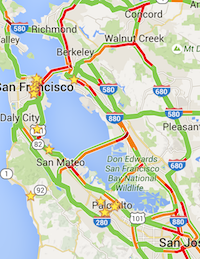|
Today's Opinions, Tomorrow's Reality
Sustaining the Sprawl By David G. Young Detroit, July 5, 2016 -- Google's automotive projects offer unwelcome aid for America's suburban dysfunction. The real estate boom that raised Art Deco skyscrapers like mushrooms in Detroit in the 1920s was a short-lived phenomenon. Speculative investments came to a crashing halt along with the stock market in 1929. Markets recovered 15 years later, but by then it was simply too late.
Two thousand miles west of Detroit, in the newer sprawl of Northern California, tech workers sit in endless traffic caused by the world that the auto barons created. Not only at rush hour, but at seemingly any time of day, the 101 Freeway linking San Jose and San Francisco grinds to a halt, leading commuters to spill out onto arterial roads plodding through the sprawl. The same is true on the bridges and other roads spanning the bay region. Google Maps' traffic overlay bleeds red with congestion at seemingly any hour. The Mountain View campus that hosts Google's workforce is the antithesis of downtown Detroit. There are no skyscrapers, no street cars, no people movers or subways. There is not even the kind of density that would make these things viable. There are only private cars and company-sponsored private busses that shuttle employees from denser areas like downtown San Francisco deep into the sprawl where today's tech barons prefer to work and live.
The big question is why? Across from the embarcadero in downtown San Francisco, a Google tower has an employee cafeteria with stunning views of the bay bridge and ferry terminal. The tower is within easy walking distance of a BART subway station, several trolley lines, and ferries that being people by the hundreds across the bay. No self-driving cars or flying vehicles are needed to get through the sprawl. A much earlier generation of transit barons used much simpler solutions like rail to get people into dense cities over a hundred years ago. But Google's downtown building houses relatively few employees, serving largely as a vanity location and sales office. Most employees living downtown must cut through 35 miles of sprawl to get to work on the edge of a south bay swamp. This is Google's choice to make, but it is not a good one. The shiny new automobiles that allowed Detroit's 1920s office workers to leave small city homes and offices for spacious suburban replacements now imprison them in gridlock and consign them to dull environs with no street life. Google's struggle to sustain the suburban world that Detroit created perpetuates this dysfunction. Clearly, this is not the intent of Page or Google's self-driving car project. But nor was it the intent of Henry Ford and his competitors to kill Detroit's urban core. What societal changes will be unleashed by new technologies are always hard to predict. But with urban centers making a comeback for the first time in decades, a disruptive change to save the suburbs is the last thing cities need. Related Web Columns: Saving the Suburbs, October 12, 2010 Tarnished Luster Who Will Kill the SUV?, April 8, 2006 Promoting Obnoxious 'Burbs, June 15, 1999 Notes: 1. Wall Street Journal, Google Co-Founder Larry Page Owns Two 'Flying Car' Companies, June 9, 2016 |



